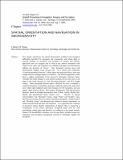| dc.description.abstract | This chapter summarizes the spatial disorientation problems and navigation difficulties described by astronauts and cosmonauts, and relates them to research findings on orientation and navigation in humans and animals. Spacecraft crew are uniquely free to float in any relative orientation with respect to the cabin, and experience no vestibular and haptic cues that directly indicate the direction of “down”. They frequently traverse areas with inconsistently aligned visual vertical cues. As a result, most experience “Visual Reorientation Illusions” (VRIs) where the spacecraft floors, walls and ceiling surfaces exchange subjective identities. The illusion apparently results from a sudden reorientation of the observer’s allocentric reference frame. Normally this frame realigns to local interior surfaces, but in some cases it can jump to the Earth beyond, as with “Inversion Illusions” and EVA height vertigo. These perceptual illusions make it difficult for crew to maintain a veridical perception of orientation and place within the spacecraft, make them more reliant upon landmark and route strategies for 3D navigation, and can trigger space motion sickness. This chapter distinguishes VRIs and Inversion Illusions, based on firsthand descriptions from Vostok, Apollo, Skylab, Mir, Shuttle and International Space Station crew. Theories on human “gravireceptor” and “idiotropic” biases, visual “frame” and “polarity” cues, top-down processing effects on object orientation perception, mental rotation and “direction vertigo” are discussed and related to animal experiments on limbic head direction and place cell responses. It is argued that the exchange in perceived surface identity characteristic of human VRIs is caused by a reorientation of the unseen allocentric navigation plane used by CNS mechanisms coding place and direction, as evidenced in the animal models. Human VRI susceptibility continues even on long flights, perhaps because our orientation and navigation mechanisms evolved to principally support 2D navigation. | en |
